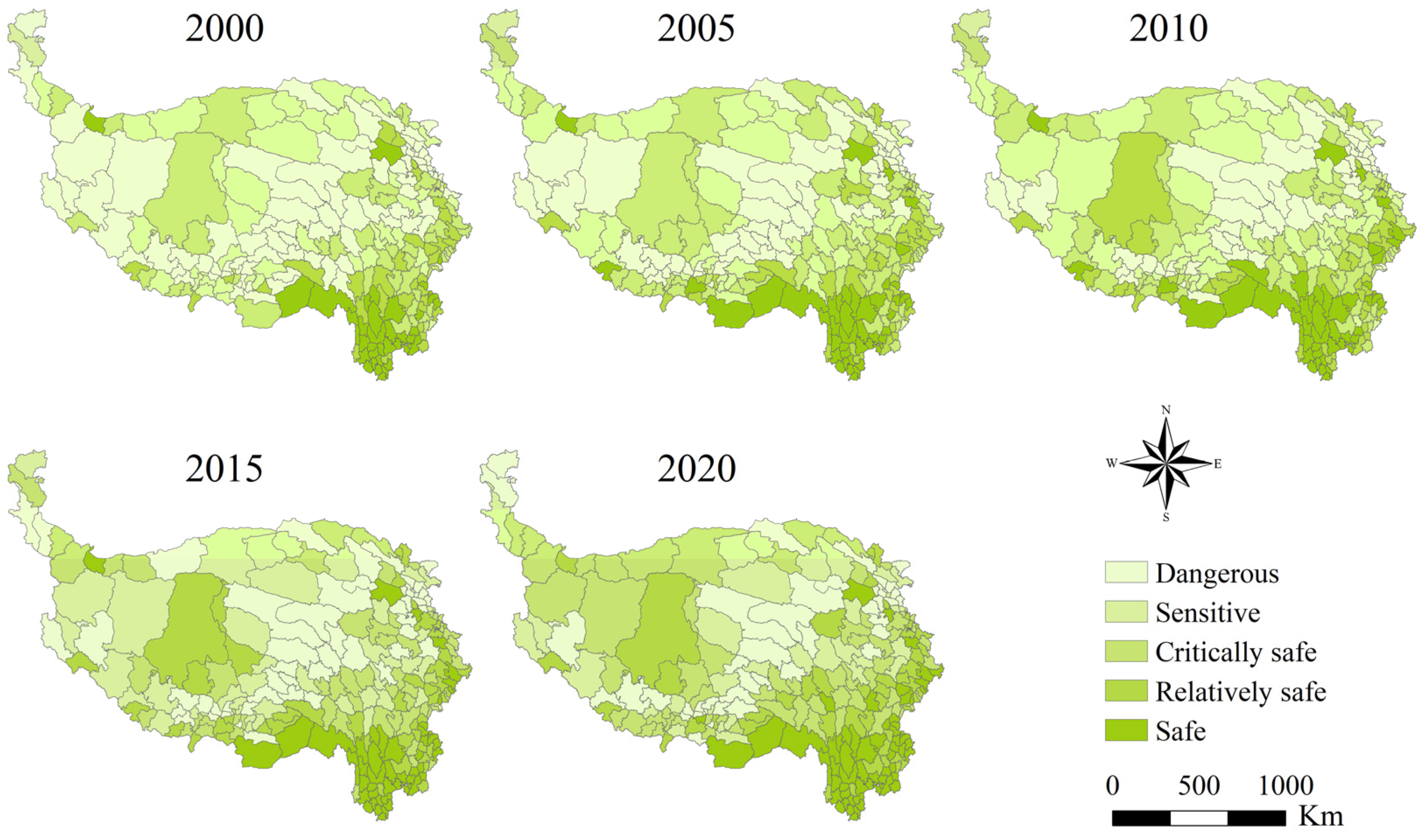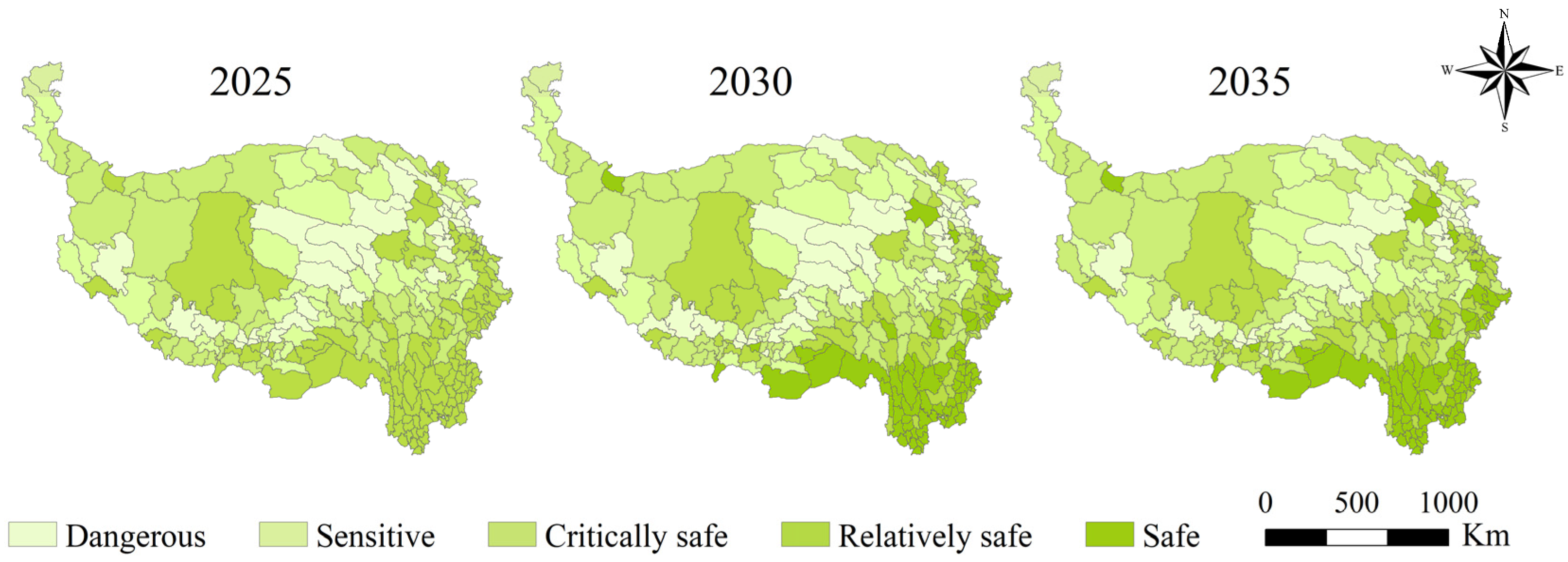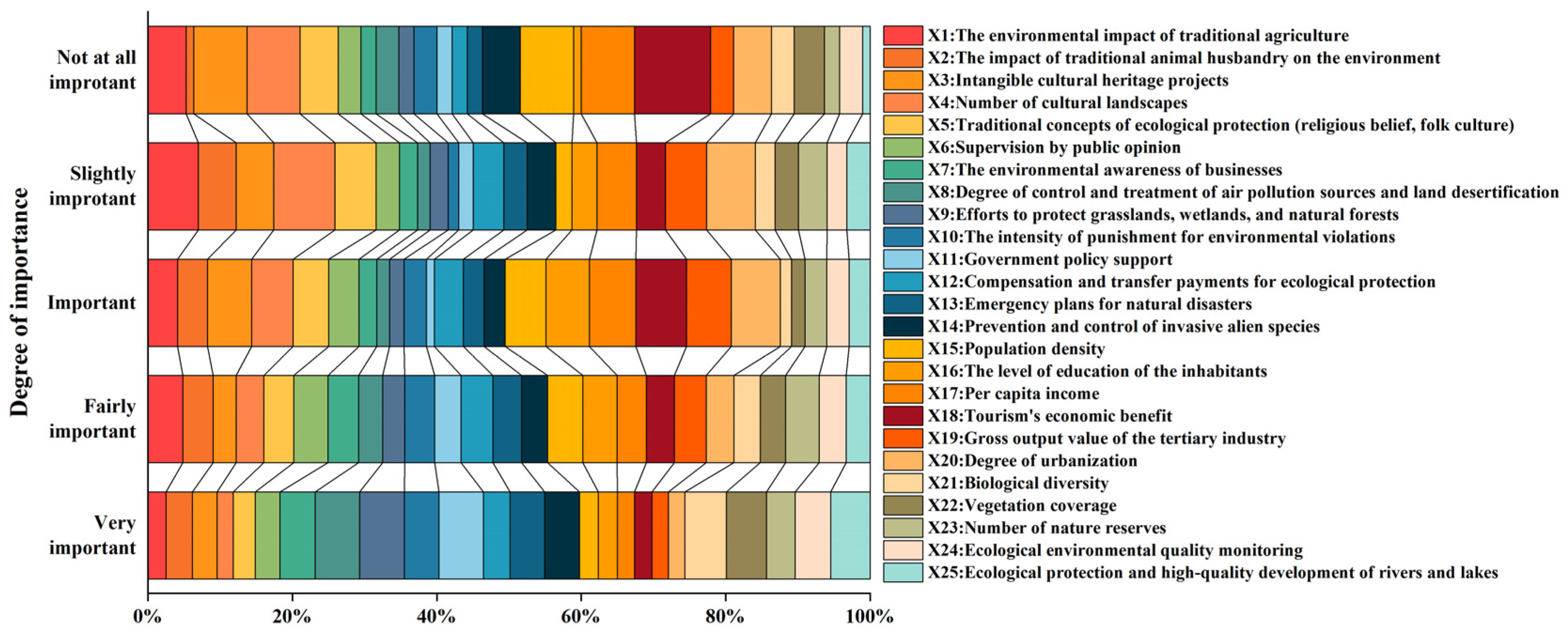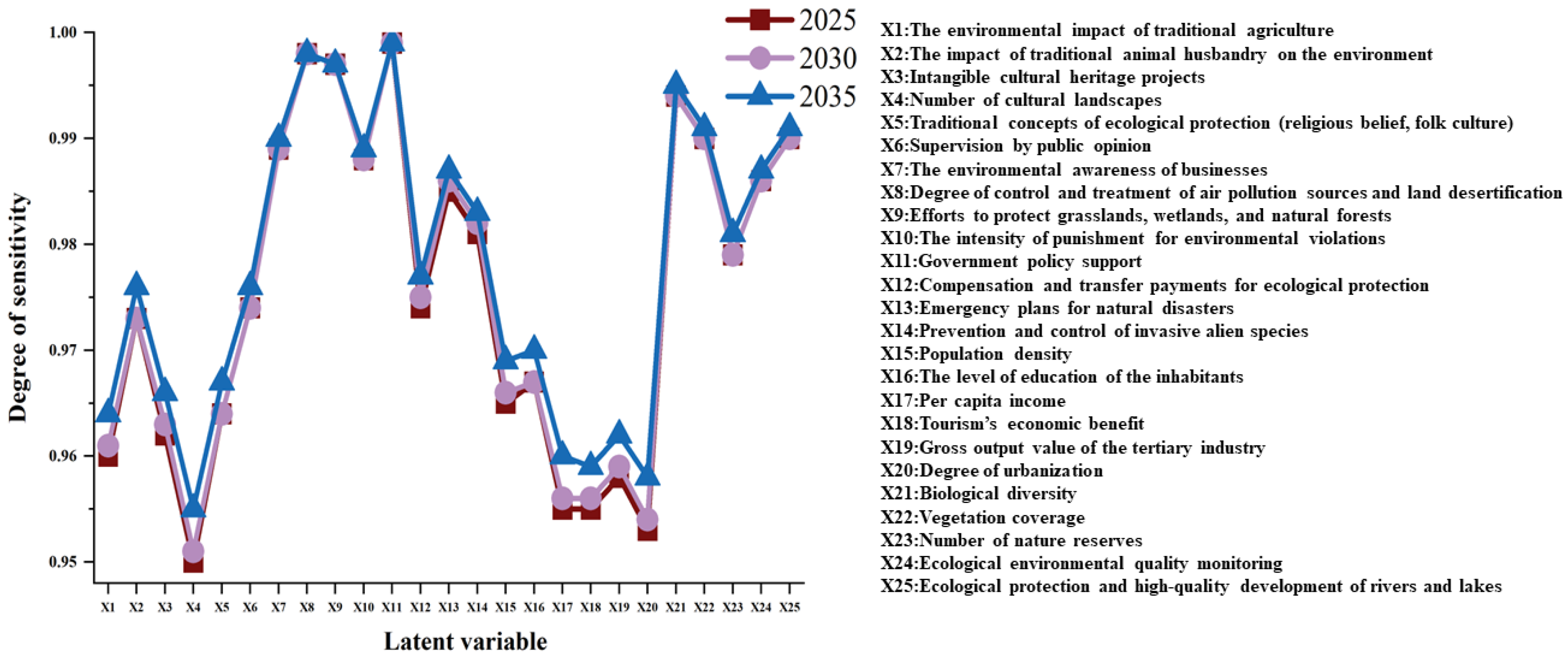Spatiotemporal Changes and Simulation Prediction of Ecological Security Pattern on the Qinghai–Tibet Plateau Based on Deep Learning
Abstract
1. Introduction
2. Materials and Methods
2.1. Study Area
2.2. Data Sources
2.3. ES Evaluation Model
2.3.1. PSR Framework Construction
2.3.2. ES Comprehensive Index Calculation
- (1)
- Standardization of indicator values
- (2)
- Entropy weight method
- (3)
- Comprehensive index calculation
2.4. Cold Hot Spot Analysis
2.5. ES Prediction
2.6. Design of Human Perception Questionnaire for ES on QTP
2.7. Grey Correlation Analysis
3. Results
3.1. Temporal and Spatial Changes in ES on the QTP
3.2. Spatial Heterogeneity of ES on the QTP
3.3. ES Prediction of QTP
3.3.1. The Comparison of the Predictive Abilities of Different Prediction Models for the ES of the QTP
3.3.2. Prediction of the ES on the QTP by Different Prediction Models
3.4. Analysis of Residents’ Perception of ES of QTP
4. Discussion
4.1. Spatial Heterogeneity of ES on the QTP
4.2. ES Prediction of QTP
4.2.1. Comparison of Predictive Models
4.2.2. Application of Deep Learning Model in This Research
4.3. Policies and Recommendations
4.4. Deficiency and Prospect
5. Conclusions
Supplementary Materials
Author Contributions
Funding
Data Availability Statement
Conflicts of Interest
References
- Nie, W.B.; Bin, X.; Yang, F.; Shi, Y.; Liu, B.T.; Wu, R.W.; Lin, W.; Pei, H.; Bao, Z.Y. Simulating future land use by coupling ecological security patterns and multiple scenarios. Sci. Total Environ. 2023, 859, 14. [Google Scholar] [CrossRef]
- Bi, M.L.; Xie, G.D.; Yao, C.Y. Ecological security assessment based on the renewable ecological footprint in the Guangdong-Hong Kong-Macao Greater Bay Area, China. Ecol. Indic. 2020, 116, 10. [Google Scholar] [CrossRef]
- Zhang, X.B.; Wang, Z.Y.; Liu, Y.; Shi, J.; Du, H.C. Ecological Security Assessment and Territory Spatial Restoration and Management of Inland River Basin-Based on the Perspective of Production-Living-Ecological Space. Land 2023, 12, 1612. [Google Scholar] [CrossRef]
- Feng, Y.J.; Yang, Q.Q.; Tong, X.H.; Chen, L.J. Evaluating land ecological security and examining its relationships with driving factors using GIS and generalized additive model. Sci. Total Environ. 2018, 633, 1469–1479. [Google Scholar] [CrossRef]
- Li, Z.X.; Chang, J.; Li, C.; Gu, S.H. Ecological Restoration and Protection of National Land Space in Coal Resource-Based Cities from the Perspective of Ecological Security Pattern: A Case Study in Huaibei City, China. Land 2023, 12, 442. [Google Scholar] [CrossRef]
- Ji, C.; Yang, H.; Pei, X.; Zhang, X.; Chen, L.; Liang, D.; Cao, Y.; Pan, J.; Chen, M. Dynamic Integrated Ecological Assessment along the Corridor of the Sichuan–Tibet Railway. Land 2024, 13, 857. [Google Scholar] [CrossRef]
- Cui, X.F.; Deng, W.; Yang, J.X.; Huang, W.; de Vries, W.T. Construction and optimization of ecological security patterns based on social equity perspective: A case study in Wuhan, China. Ecol. Indic. 2022, 136, 10. [Google Scholar] [CrossRef]
- Li, J.Y.; Chen, X.; De Maeyer, P.; van de Voorde, T.; Li, Y.M. Ecological security warning in Central Asia: Integrating ecosystem services protection under SSPs-RCPs scenarios. Sci. Total Environ. 2024, 912, 17. [Google Scholar] [CrossRef]
- Li, L.M.; Wu, J.; Lu, J.; Li, K.X.; Zhang, X.Y.; Min, X.Y.; Gao, C.L.; Xu, J. Water quality evaluation and ecological-health risk assessment on trace elements in surface water of the northeastern Qinghai-Tibet Plateau. Ecotox. Environ. Saf. 2022, 241, 10. [Google Scholar] [CrossRef]
- Wen, J.F.; Hou, K. Research on the progress of regional ecological security evaluation and optimization of its common limitations. Ecol. Indic. 2021, 127, 10. [Google Scholar] [CrossRef]
- Zhang, J.J.; Hao, X.M.; Li, X.W.; Fan, X.; Zhang, S. Evaluation and regulation strategy for ecological security in the Tarim River Basin based on the ecological footprint. J. Clean. Prod. 2024, 435, 15. [Google Scholar] [CrossRef]
- Xie, B.; Jones, P.; Dwivedi, R.; Bao, L.L.; Liang, R.B. Evaluation, comparison, and unique features of ecological security in southwest China: A case study of Yunnan Province. Ecol. Indic. 2023, 153, 11. [Google Scholar] [CrossRef]
- Lin, Y.Y.; Zhang, F.Z.; Cai, G.; Jin, Y.D.; Zhang, L.; Ge, Y. Spatio-temporal pattern and driving factors of tourism ecological security in Fujian Province. Ecol. Indic. 2023, 157, 14. [Google Scholar] [CrossRef]
- Hazbavi, Z.; Sadeghi, S.H.; Gholamalifard, M.; Davudirad, A.A. Watershed health assessment using the pressure-state-response (PSR) framework. Land Degrad. Dev. 2020, 31, 3–19. [Google Scholar] [CrossRef]
- Tian, S.; Zhang, Y.J.; Xu, Y.; Wang, Q.S.; Yuan, X.L.; Ma, Q.; Chen, L.P.; Ma, H.C.; Xu, Y.; Yang, S.; et al. Urban ecological security assessment and path regulation for ecological protection—A case study of Shenzhen, China. Ecol. Indic. 2022, 145, 12. [Google Scholar] [CrossRef]
- Li, W.L.; Liu, C.L.; Su, W.L.; Ma, X.L.; Zhou, H.K.; Wang, W.Y.; Zhu, G.F. Spatiotemporal evaluation of alpine pastoral ecosystem health by using the Basic-Pressure-State-Response Framework: A case study of the Gannan region, northwest China. Ecol. Indic. 2021, 129, 12. [Google Scholar] [CrossRef]
- Gao, Y.; Zhang, C.R.; He, Q.S.; Liu, Y.L. Urban Ecological Security Simulation and Prediction Using an Improved Cellular Automata (CA) Approach-A Case Study for the City of Wuhan in China. Int. J. Environ. Res. Public Health 2017, 14, 643. [Google Scholar] [CrossRef]
- Zhang, H.B.; Yan, Q.Q.; Xie, F.F.; Ma, S.C. Evaluation and Prediction of Landscape Ecological Security Based on a CA-Markov Model in Overlapped Area of Crop and Coal Production. Land 2023, 12, 207. [Google Scholar] [CrossRef]
- Wang, H.P.; Zhang, Z. A spatial lagged multivariate discrete grey model for forecasting an economy-energy-environment system. J. Clean. Prod. 2023, 404, 16. [Google Scholar] [CrossRef]
- Dutta, M.K.; Arhonditsis, G. Empowering novel scholarship at the intersection of machine learning/deep learning and ecology. Ecol. Inform. 2023, 77, 2. [Google Scholar] [CrossRef]
- Wu, Q.L.; Lin, H.X. A novel optimal-hybrid model for daily air quality index prediction considering air pollutant factors. Sci. Total Environ. 2019, 683, 808–821. [Google Scholar] [CrossRef]
- Tuia, D.; Kellenberger, B.; Beery, S.; Costelloe, B.R.; Zuffi, S.; Risse, B.; Mathis, A.; Mathis, M.W.; van Langevelde, F.; Burghardt, T.; et al. Perspectives in machine learning for wildlife conservation. Nat. Commun. 2022, 13, 15. [Google Scholar] [CrossRef]
- Dehghani, A.; Moazam, H.; Mortazavizadeh, F.; Ranjbar, V.; Mirzaei, M.; Mortezavi, S.; Ng, J.L.; Dehghani, A. Comparative evaluation of LSTM, CNN, and ConvLSTM for hourly short-term streamflow forecasting using deep learning approaches. Ecol. Inform. 2023, 75, 12. [Google Scholar] [CrossRef]
- Zhang, H.P.; Chen, W.; Liu, W.D.; Liu, Z.G.; Liu, H.C. The evolution of settlement system and the paths of rural revitalization in alpine pastoral areas of the Qinghai-Tibet Plateau: A case study of Nagqu County. Ecol. Indic. 2023, 150, 13. [Google Scholar] [CrossRef]
- Sang, Y.M.; Xin, L.J. Factors Determining Concurrent Reclamation and Abandonment of Cultivated Land on the Qinghai-Tibet Plateau. Land 2023, 12, 1081. [Google Scholar] [CrossRef]
- Xue, J.; Li, Z.X.; Du, F.; Ruan, J.L.; Gui, J. Dynamics changes and prediction of ecosystem services in the Qinghai-Tibet Plateau, western China. Glob. Ecol. Conserv. 2023, 47, 14. [Google Scholar] [CrossRef]
- Liu, J.Y.; Qin, K.Y.; Xie, G.D.; Xiao, Y.; Huang, M.D.; Gan, S. Is the ‘water tower’ reassuring? Viewing water security of Qinghai-Tibet Plateau from the perspective of ecosystem services ‘supply-flow-demand’. Environ. Res. Lett. 2022, 17, 11. [Google Scholar] [CrossRef]
- Xie, H.L.; He, Y.F.; Choi, Y.; Chen, Q.R.; Cheng, H. Warning of negative effects of land-use changes on ecological security based on GIS. Sci. Total Environ. 2020, 704, 9. [Google Scholar] [CrossRef]
- Wang, Z.Q.; Cui, G.L.; Liu, X.; Zheng, K.; Lu, Z.Y.; Li, H.L.; Wang, G.N.; An, Z.F. Greening of the Qinghai-Tibet Plateau and Its Response to Climate Variations along Elevation Gradients. Remote Sens. 2021, 13, 3712. [Google Scholar] [CrossRef]
- Yu, L.; Liu, S.L.; Wang, F.F.; Liu, Y.X.; Li, M.Q.; Wang, Q.B.; Dong, S.K.; Zhao, W.W.; Tran, L.S.P.; Sun, Y.X.; et al. Effects of agricultural activities on energy-carbon-water nexus of the Qinghai-Tibet Plateau. J. Clean. Prod. 2022, 331, 13. [Google Scholar] [CrossRef]
- Zhang, L.D.; Peng, W.F.; Zhang, J. Assessment of Land Ecological Security from 2000 to 2020 in the Chengdu Plain Region of China. Land 2023, 12, 1448. [Google Scholar] [CrossRef]
- Fan, Y.P.; Fang, C.L. Evolution process and obstacle factors of ecological security in western China, a case study of Qinghai province. Ecol. Indic. 2020, 117, 8. [Google Scholar] [CrossRef]
- Fu, C.W.; Hu, Z.Y.; Yang, Y.X.; Deng, M.S.; Yu, H.P.; Lu, S.; Wu, D.; Fan, W.W. Responses of Soil Freeze-Thaw Processes to Climate on the Tibetan Plateau from 1980 to 2016. Remote Sens. 2022, 14, 5907. [Google Scholar] [CrossRef]
- Chen, T.S.; Huang, L.B.; Zhang, X.; Gao, R.; Li, H.; Fan, K.; Ma, D.; Ma, Z.K.; Xue, L.K.; Wang, W.X. Effects of coal chemical industry on atmospheric volatile organic compounds emission and ozone formation in a northwestern Chinese city. Sci. Total Environ. 2022, 839, 9. [Google Scholar] [CrossRef]
- Cheng, H.R.; Zhu, L.K.; Meng, J.J. Fuzzy evaluation of the ecological security of land resources in mainland China based on the Pressure-State-Response framework. Sci. Total Environ. 2022, 804, 14. [Google Scholar] [CrossRef]
- Lu, T.; Li, C.J.; Zhou, W.X.; Liu, Y.X. Fuzzy Assessment of Ecological Security on the Qinghai-Tibet Plateau Based on Pressure-State-Response Framework. Remote Sens. 2023, 15, 1293. [Google Scholar] [CrossRef]
- Wen, X.; Deng, X.Z. Current soil erosion assessment in the Loess Plateau of China: A mini-review. J. Clean. Prod. 2020, 276, 10. [Google Scholar] [CrossRef]
- Guo, Z.; Yan, Z.; He, R.; Yang, H.; Ci, H.; Wang, R. Impacts of Land Use Conversion on Soil Erosion in the Urban Agglomeration on the Northern Slopes of the Tianshan Mountains. Land 2024, 13, 550. [Google Scholar] [CrossRef]
- Sikder, M.; Wang, C.; Yao, X.X.; Huai, X.; Wu, L.M.; KwameYeboah, F.; Wood, J.; Zhao, Y.L.; Dou, X.C. The integrated impact of GDP growth, industrialization, energy use, and urbanization on CO2 emissions in developing countries: Evidence from the panel ARDL approach. Sci. Total Environ. 2022, 837, 16. [Google Scholar] [CrossRef] [PubMed]
- Zhang, S.D.; Wu, T.; Guo, L.; Zou, H.T.; Shi, Y. Integrating ecosystem services supply and demand on the Qinghai-Tibetan Plateau using scarcity value assessment. Ecol. Indic. 2023, 147, 14. [Google Scholar] [CrossRef]
- Guo, J.; Qi, Y.; Zhang, L.; Zheng, J.; Sun, J.; Tang, Y.; Yang, X. Identifying and Mapping the Spatial Factors That Control Soil Erosion Changes in the Yellow River Basin of China. Land 2024, 13, 344. [Google Scholar] [CrossRef]
- Zhang, R.; Wang, C.L.; Xiong, Y.C. Ecological security assessment of China based on the Pressure-State-Response framework. Ecol. Indic. 2023, 154, 10. [Google Scholar] [CrossRef]
- Ren, E.; Lin, W.; Li, B.; Jiang, Y.; Zhang, Y.; Yu, Y. Regional Ecological Security Assessment Based on the Pressure–State–Response Framework: The Demonstration Zone of Yangtze River Delta as an Example. Land 2024, 13, 96. [Google Scholar] [CrossRef]
- Xi, H.Y.; Chen, Y.Q.; Zhao, X.Y.; Sindikubwabo, C.; Cheng, W.J. Safety assessment of fragile environment in Badain Jaran Desert and its surrounding areas based on the DPSIR model. Ecol. Indic. 2023, 146, 9. [Google Scholar] [CrossRef]
- Li, R.; Shi, Y.; Feng, C.C.; Guo, L. The spatial relationship between ecosystem service scarcity value and urbanization from the perspective of heterogeneity in typical arid and semiarid regions of China. Ecol. Indic. 2021, 132, 13. [Google Scholar] [CrossRef]
- Sahani, N.; Ghosh, T. GIS-based spatial prediction of recreational trail susceptibility in protected area of Sikkim Himalaya using logistic regression, decision tree and random forest model. Ecol. Inform. 2021, 64, 17. [Google Scholar] [CrossRef]
- Yuan, J.; Gao, H.; Shen, Y.L.; Ma, G.Q. Spatial Differentiation of Ecotourist Perceptions Based on the Random Forest Model: The Case of the Gansu Section of the Yellow River Basin. Land 2024, 13, 560. [Google Scholar] [CrossRef]
- Jiang, Q.; Liu, W.; Wu, S.P. Analysis on factors affecting moisture stability of steel slag asphalt concrete using grey correlation method. J. Clean. Prod. 2023, 397, 15. [Google Scholar] [CrossRef]
- Geng, Y.Q.; Chen, L.Y.; Li, J.Y.; Iqbal, K. Higher education and digital Economy: Analysis of their coupling coordination with the Yangtze River economic Belt in China as the example. Ecol. Indic. 2023, 154, 16. [Google Scholar] [CrossRef]
- Long, X.; Wu, S.G.; Wang, J.Y.; Wu, P.Z.; Wang, Z. Urban water environment carrying capacity based on VPOSR-coefficient of variation-grey correlation model: A case of Beijing, China. Ecol. Indic. 2022, 138, 10. [Google Scholar] [CrossRef]
- Wang, F.L.; Fu, W.; Chen, J.C. Spatial-Temporal Evolution of Ecosystem Service Value in Yunnan Based on Land Use. Land 2022, 11, 2217. [Google Scholar] [CrossRef]
- Zhu, D.; Niu, Q.; Wang, Y.H.; Peng, S.G.; Lu, X.L.; Zhou, H.C.; Zhang, F.L. The influence of psychological cognition and policy environment on the basin residents? behavior of ecological compensation under the background of carbon neutrality: A case study in upper Yellow River basin, China. Ecol. Indic. 2023, 148, 12. [Google Scholar] [CrossRef]
- Airiken, M.; Li, S.C. The Dynamic Monitoring and Driving Forces Analysis of Ecological Environment Quality in the Tibetan Plateau Based on the Google Earth Engine. Remote Sens. 2024, 16, 682. [Google Scholar] [CrossRef]
- Liu, X.X.; Zhao, W.W.; Liu, Y.X.; Hua, T.; Hu, X.P.; Cherubini, F. Contributions of ecological programs to sustainable development goals in Linzhi, over the Tibetan Plateau: A mental map perspective. Ecol. Eng. 2022, 176, 9. [Google Scholar] [CrossRef]
- Garcia-Rodriguez, D.; Ruber, P.C.; Iglesias Fuente, D.J.; Durá, J.J.M.; Baeza, E.L.; Celda, A.G. Predicting the fundamental fluxes of an eddy-covariance station using machine learning methods. Ecol. Inform. 2024, 81, 102638. [Google Scholar] [CrossRef]
- Kaveh, N.; Ebrahimi, A.; Asadi, E. Comparative analysis of random forest, exploratory regression, and structural equation modeling for screening key environmental variables in evaluating rangeland above-ground biomass. Ecol. Inform. 2023, 77, 15. [Google Scholar] [CrossRef]
- Yin, L.R.; Wang, L.; Li, T.Q.; Lu, S.Y.; Tian, J.W.; Yin, Z.T.; Li, X.L.; Zheng, W.F. U-Net-LSTM: Time Series-Enhanced Lake Boundary Prediction Model. Land 2023, 12, 1859. [Google Scholar] [CrossRef]
- Shim, J.; Hong, S.; Lee, J.; Lee, S.Y.; Kim, Y.M.; Chon, K.; Park, S.; Cho, K.H. Deep learning with data preprocessing methods for water quality prediction in ultrafiltration. J. Clean. Prod. 2023, 428, 13. [Google Scholar] [CrossRef]








| Name | Resolution | Source |
|---|---|---|
| Land use | 1000 m | Resource and Environmental Science Data Platform (https://www.resdc.cn (accessed on 12 September 2023)) |
| GDP | 1000 m | |
| Population density | 1000 m | |
| Average annual precipitation | 1000 m | |
| NDVI | 1000 m | |
| DEM | 30 m | Geospatial Data Cloud (https://www.gscloud.cn/ (accessed on 12 September 2023)) |
| Soil data | 1000 m | Chinese Soil Dataset (v1.1) of the World Soil Database (HWSD) |
| Permafrost rate | 1000 m | National QTP Scientific Data Center (https://data.tpdc.ac.cn/ (accessed on 12 September 2023)) |
| Socio-economic data | - | County statistical yearbooks of Tibet, Qinghai, Xinjiang, Gansu, Sichuan, and Yunnan |
| Target Layer | Criterion Layer | Index Layer | Stats | Weight |
|---|---|---|---|---|
| ES in QTP (A) | Pressure | Permafrost ratio/% | - | 0.101266 |
| Proportion of primary industry/% | - | 0.063291 | ||
| Population/a | - | 0.075949 | ||
| State | Slope/° | - | 0.088608 | |
| Annual precipitation/mm | + | 0.075949 | ||
| Degree of soil erosion | - | 0.063291 | ||
| Output of animal husbandry/% | - | 0.088608 | ||
| Response | GDP/2020 US$ | - | 0.088608 | |
| Proportion of tertiary industry/% | + | 0.088608 | ||
| Ecosystem service value/2020 US$ | + | 0.265822 |
| Latent Variable | Observed Variable |
|---|---|
| Social governance | Supervision by public opinion |
| Degree of control and treatment of air pollution sources and land desertification | |
| Efforts to protect grasslands, wetlands, and natural forests | |
| Environmental awareness of businesses | |
| The intensity of punishment for environmental violations | |
| Government supervision | Emergency plans for natural disasters |
| Prevention and control of invasive alien species | |
| Government policy support | |
| Compensation and transfer payments for ecological protection | |
| Social and economic development | Population density |
| Level of education of inhabitants | |
| Per capita income | |
| Tourism’s economic benefit | |
| Gross output value of tertiary industry | |
| Degree of urbanization | |
| Ecological protection | Biological diversity |
| Vegetation coverage | |
| Number of nature reserves | |
| Ecological environmental quality monitoring | |
| Ecological protection and high-quality development of rivers and lakes | |
| Influence of traditional culture | Number of cultural landscapes |
| Intangible cultural heritage projects | |
| Impact of traditional animal husbandry on the environment | |
| Environmental impact of traditional agriculture | |
| Traditional concepts of ecological protection (religious belief, folk culture) |
| RMSE | R2 | ||||||
|---|---|---|---|---|---|---|---|
| LR | RF | CNN | LSTM | LR | RF | CNN | LSTM |
| 0.02383 | 0.02110 | 0.02243 | 0.02036 | 0.81015 | 0.85124 | 0.83183 | 0.86149 |
Disclaimer/Publisher’s Note: The statements, opinions and data contained in all publications are solely those of the individual author(s) and contributor(s) and not of MDPI and/or the editor(s). MDPI and/or the editor(s) disclaim responsibility for any injury to people or property resulting from any ideas, methods, instructions or products referred to in the content. |
© 2024 by the authors. Licensee MDPI, Basel, Switzerland. This article is an open access article distributed under the terms and conditions of the Creative Commons Attribution (CC BY) license (https://creativecommons.org/licenses/by/4.0/).
Share and Cite
Liu, L.; Zhang, S.; Liu, W.; Qu, H.; Guo, L. Spatiotemporal Changes and Simulation Prediction of Ecological Security Pattern on the Qinghai–Tibet Plateau Based on Deep Learning. Land 2024, 13, 1073. https://doi.org/10.3390/land13071073
Liu L, Zhang S, Liu W, Qu H, Guo L. Spatiotemporal Changes and Simulation Prediction of Ecological Security Pattern on the Qinghai–Tibet Plateau Based on Deep Learning. Land. 2024; 13(7):1073. https://doi.org/10.3390/land13071073
Chicago/Turabian StyleLiu, Longqing, Shidong Zhang, Wenshu Liu, Hongjiao Qu, and Luo Guo. 2024. "Spatiotemporal Changes and Simulation Prediction of Ecological Security Pattern on the Qinghai–Tibet Plateau Based on Deep Learning" Land 13, no. 7: 1073. https://doi.org/10.3390/land13071073
APA StyleLiu, L., Zhang, S., Liu, W., Qu, H., & Guo, L. (2024). Spatiotemporal Changes and Simulation Prediction of Ecological Security Pattern on the Qinghai–Tibet Plateau Based on Deep Learning. Land, 13(7), 1073. https://doi.org/10.3390/land13071073








